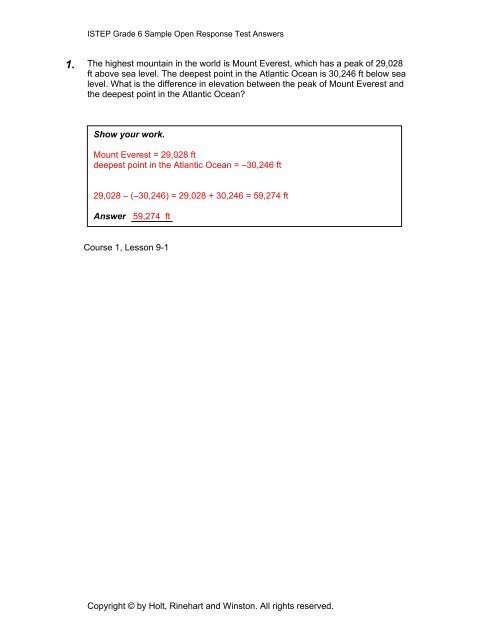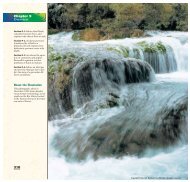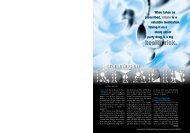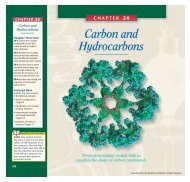ISTEP Grade 6 Sample Open Response Test Answers
ISTEP Grade 6 Sample Open Response Test Answers
ISTEP Grade 6 Sample Open Response Test Answers
You also want an ePaper? Increase the reach of your titles
YUMPU automatically turns print PDFs into web optimized ePapers that Google loves.
1.<br />
<strong>ISTEP</strong> <strong>Grade</strong> 6 <strong>Sample</strong> <strong>Open</strong> <strong>Response</strong> <strong>Test</strong> <strong>Answers</strong><br />
The highest mountain in the world is Mount Everest, which has a peak of 29,028<br />
ft above sea level. The deepest point in the Atlantic Ocean is 30,246 ft below sea<br />
level. What is the difference in elevation between the peak of Mount Everest and<br />
the deepest point in the Atlantic Ocean?<br />
Show your work.<br />
Mount Everest = 29,028 ft<br />
deepest point in the Atlantic Ocean = –30,246 ft<br />
29,028 – (–30,246) = 29,028 + 30,246 = 59,274 ft<br />
Answer 59,274 ft<br />
Course 1, Lesson 9-1<br />
Copyright © by Holt, Rinehart and Winston. All rights reserved.
2.<br />
<strong>ISTEP</strong> <strong>Grade</strong> 6 <strong>Sample</strong> <strong>Open</strong> <strong>Response</strong> <strong>Test</strong> <strong>Answers</strong><br />
Write each number in the list below in decimal form and then order the decimals<br />
from least to greatest. Explain how you write fractions as decimals<br />
Decimal Form<br />
1<br />
2<br />
= 0.5<br />
–2 = –2.0<br />
1<br />
7 4 = 7.25<br />
0.6 = 0.6<br />
1<br />
− 2 = −2.2<br />
5<br />
7.4 = 7.4<br />
1<br />
, −2,<br />
2 1<br />
7 4 , 0.6,<br />
1<br />
− 2 , 7.4<br />
5<br />
To write a fraction as a decimal, divide the numerator by the denominator.<br />
Course 1, Lessons 3-1, 4-4, and 9-2<br />
Ordered from least to greatest<br />
– ____ 2.2 , – ____ 2.0 , ____ 0.5 , ____ 0.6 , ____ 7.25 , ____<br />
7.4<br />
Copyright © by Holt, Rinehart and Winston. All rights reserved.
3.<br />
<strong>ISTEP</strong> <strong>Grade</strong> 6 <strong>Sample</strong> <strong>Open</strong> <strong>Response</strong> <strong>Test</strong> <strong>Answers</strong><br />
A country-music band takes about 5 hours to rehearse 2 new songs. If they are<br />
going to play 9 new songs in their show, how many hours should they plan to<br />
rehearse? Write a proportion to solve the problem.<br />
Show your work.<br />
5 hours h hours<br />
=<br />
2 songs 9 songs<br />
5• 9 = h •2<br />
45 = 2h<br />
45 2h<br />
=<br />
2 2<br />
22.5 = h<br />
Answer h = 22.5 hours<br />
Course 1, Lesson 8-2<br />
Copyright © by Holt, Rinehart and Winston. All rights reserved.
4.<br />
<strong>ISTEP</strong> <strong>Grade</strong> 6 <strong>Sample</strong> <strong>Open</strong> <strong>Response</strong> <strong>Test</strong> <strong>Answers</strong><br />
Paul wants to buy a book about the history of the Super Bowl. The regular price<br />
of the book is $27.90, but it is on sale for 30% off the regular price. What is the<br />
sale price of the book?<br />
Show your work.<br />
To write a percent as a decimal, move the decimal point 2 places to the left<br />
OR divide the percent by 100.<br />
Possible methods for solving:<br />
$27.90 × 30 % = $27.90 × 0.30 = $8.37<br />
$27.90 – $8.37 = $19.53<br />
OR<br />
$27.90 × 70 % = $27.90 × 0.70 = $19.53<br />
Answer $19.53<br />
Use the lines below to explain how to convert from a percent to a decimal.<br />
Course 1, Lesson 8-10<br />
Copyright © by Holt, Rinehart and Winston. All rights reserved.
5.<br />
<strong>ISTEP</strong> <strong>Grade</strong> 6 <strong>Sample</strong> <strong>Open</strong> <strong>Response</strong> <strong>Test</strong> <strong>Answers</strong><br />
A toy manufacturer is building a child’s playhouse based on the model shown<br />
below. The size of the playhouse is going to be 4 times the size of the model.<br />
Use the dimensions of the model to determine the dimensions (in feet and in<br />
inches) of the playhouse.<br />
Show your work.<br />
Length<br />
length = 4 × 12.25 = 49<br />
in.<br />
length = 49 in.<br />
Width<br />
width = 4 × 14 = 56 in.<br />
width = 56 in.<br />
Now write the dimensions of the playhouse in feet and inches.<br />
Copyright © by Holt, Rinehart and Winston. All rights reserved.<br />
Height<br />
height = 4 × 18.5 = 74 in.<br />
height = 74 in.<br />
length = 4 ft 1 in. width = 4 ft 8 in. height = 6 ft 2 in.<br />
Course 1, Lesson 8-6<br />
Height =<br />
1<br />
18 2 in.<br />
Length =<br />
1<br />
12 in.<br />
4<br />
Width = 14 in.
6.<br />
<strong>ISTEP</strong> <strong>Grade</strong> 6 <strong>Sample</strong> <strong>Open</strong> <strong>Response</strong> <strong>Test</strong> <strong>Answers</strong><br />
Sara spent $28 at the county fair. If the cost of admission was $6 and each ride<br />
cost $2, how many rides did Sara ride? Define a variable. Then write an equation<br />
and solve it.<br />
Show your work.<br />
Variable: Let r = the number of rides Sara rode.<br />
Equation: 6 + 2r = 28<br />
Answer 11 rides<br />
Course 1, Lessons 2-3, 2-4, and 9-8<br />
6 + 2r = 28<br />
– 6 – 6<br />
2r = 22<br />
2 2<br />
r = 11<br />
Copyright © by Holt, Rinehart and Winston. All rights reserved.
7.<br />
<strong>ISTEP</strong> <strong>Grade</strong> 6 <strong>Sample</strong> <strong>Open</strong> <strong>Response</strong> <strong>Test</strong> <strong>Answers</strong><br />
Use the order of operations to evaluate the expression<br />
3 · 4 + (5 2 + 4 · 2) – 9. Explain your method.<br />
Show your work.<br />
3 · 4 + (5 2 + 4 · 2) – 9<br />
= 3• 4 + (25+ 8) −9<br />
= 3• 4 + (33) −9<br />
= 12 + 33 −9<br />
= 36<br />
Perform the operations inside the parentheses first; square 5 and multiply 4 and 2,<br />
and then add 25 and 8. Perform all multiplication from left to right, and then add and<br />
subtract from left to right.<br />
Answer 36<br />
Course 1, Lesson 1-4<br />
Copyright © by Holt, Rinehart and Winston. All rights reserved.
8.<br />
<strong>ISTEP</strong> <strong>Grade</strong> 6 <strong>Sample</strong> <strong>Open</strong> <strong>Response</strong> <strong>Test</strong> <strong>Answers</strong><br />
Complete the table of values for the equation below. Then, using the ordered<br />
pairs, graph the line on the grid provided.<br />
SOLUTION<br />
x y<br />
–1<br />
0<br />
1<br />
2<br />
x y<br />
–1 −4<br />
0 −2<br />
1 0<br />
2 2<br />
2x – y = 2<br />
Course 1, Lessons 12-1 and 12-2<br />
−5 −4 −3 −2 −1 1 2 3 4 5<br />
−1<br />
−2<br />
−3<br />
−4<br />
−5<br />
Copyright © by Holt, Rinehart and Winston. All rights reserved.<br />
y<br />
5<br />
4<br />
3<br />
2<br />
1<br />
y<br />
5<br />
4<br />
3<br />
2<br />
1<br />
−5 −4 −3 −2 −1 1 2 3 4 5<br />
−1<br />
−2<br />
−3<br />
−4<br />
−5<br />
x<br />
x
9.<br />
<strong>ISTEP</strong> <strong>Grade</strong> 6 <strong>Sample</strong> <strong>Open</strong> <strong>Response</strong> <strong>Test</strong> <strong>Answers</strong><br />
Use the information provided and the diagram below to find the measure of<br />
∠ TQS . Explain how you arrived at your answer.<br />
Given: PR<br />
is a straight line.<br />
SOLUTION<br />
Answer 38°<br />
Explain how you arrived at your answer.<br />
Since PR<br />
is a straight line, it measures 180°.<br />
∠ PQT = 90° since it is marked as a right angle.<br />
90° + 52° = 142°<br />
180° – 142° = 38°<br />
or<br />
Since ∠ PQT = 90°, ∠ TQR = 90°. 90° – 52° = 38°<br />
Course 1, Lesson 7-3<br />
P<br />
Copyright © by Holt, Rinehart and Winston. All rights reserved.<br />
Q<br />
T<br />
52º<br />
S<br />
R
10.<br />
<strong>ISTEP</strong> <strong>Grade</strong> 6 <strong>Sample</strong> <strong>Open</strong> <strong>Response</strong> <strong>Test</strong> <strong>Answers</strong><br />
Use the diagram below to find the measure of the unknown angle and then<br />
determine whether triangle ABC is an equilateral triangle, an isosceles triangle,<br />
or a scalene triangle. Explain how you arrived at your answer.<br />
SOLUTION<br />
Answer x = 52°<br />
A<br />
The triangle is a scalene triangle.<br />
Explain how you arrived at your answer.<br />
In any triangle, the sum of the measures of the angles is 180°. The sum of the<br />
measures of the two given angles is 128°. 180° – 128° = 52°, so the measure of<br />
the third angle is 52°. Since none of the angles have equal measures, none of<br />
the sides have equal lengths. This means the triangle is a scalene triangle.<br />
Course 1, Lesson 7-5<br />
48°<br />
Copyright © by Holt, Rinehart and Winston. All rights reserved.<br />
C<br />
80°<br />
x°<br />
B
11.<br />
<strong>ISTEP</strong> <strong>Grade</strong> 6 <strong>Sample</strong> <strong>Open</strong> <strong>Response</strong> <strong>Test</strong> <strong>Answers</strong><br />
What is the degree measure of an angle that has twice the measure of its<br />
supplement? Write an equation and use it to find the measure of the angle.<br />
Show your work.<br />
2x = angle, x = supplement<br />
2x + x = 180°<br />
3x = 180°<br />
x = 60°<br />
Since the angle = 2x, the answer is 2(60°) = 120°.<br />
Answer 120 °<br />
Course 1, Lessons 7-3, 2-3, and 2-6<br />
Copyright © by Holt, Rinehart and Winston. All rights reserved.
12.<br />
<strong>ISTEP</strong> <strong>Grade</strong> 6 <strong>Sample</strong> <strong>Open</strong> <strong>Response</strong> <strong>Test</strong> <strong>Answers</strong><br />
Sarah’s mother is flying from Richmond, Virginia, to San Francisco, California.<br />
Her flight will stop in Houston, Texas, for 50 minutes. The flight from Richmond to<br />
Houston takes 1 hour 45 minutes, and the flight from Houston to San Francisco<br />
takes 2 hours. What is the total length of the trip, including the 50-minute stop?<br />
Show your work.<br />
Let x = the total length of the trip.<br />
Add the minutes first:<br />
50 min + 1 h 45 min + 2 h = x<br />
95 min + 3 h = x<br />
4 h 35 min = x<br />
Answer 4 hours 35 minutes<br />
Course 1, Lesson 8-3<br />
Copyright © by Holt, Rinehart and Winston. All rights reserved.
13.<br />
<strong>ISTEP</strong> <strong>Grade</strong> 6 <strong>Sample</strong> <strong>Open</strong> <strong>Response</strong> <strong>Test</strong> <strong>Answers</strong><br />
John has three 2-gallon containers of gasoline. Two of the containers are full,<br />
and the third is half full. How many quarts of gasoline does John have?<br />
Show your work.<br />
2 full containers: 2 containers × 2 gallons 4 gallons<br />
1 half full container: 1 container × 1 gallons + 1 gallon<br />
5 gallons<br />
1 gallon = 4 quarts<br />
5 gallons ×<br />
Answer 20 qt<br />
Course 1, Lesson 8-3<br />
4 quarts<br />
20 quarts<br />
1 gallon =<br />
Copyright © by Holt, Rinehart and Winston. All rights reserved.
14.<br />
<strong>ISTEP</strong> <strong>Grade</strong> 6 <strong>Sample</strong> <strong>Open</strong> <strong>Response</strong> <strong>Test</strong> <strong>Answers</strong><br />
Find the area of the figure below, given that MN is the diameter of the semicircle.<br />
Use 3.14 as an approximation for π. Explain how you arrived at your answer.<br />
Show your work.<br />
Course 1, Lesson 10-5<br />
M N<br />
12 cm<br />
<strong>Sample</strong> explanation: Since the figure is a semicircle, you divide the equation<br />
for the area of a circle by 2 (or multiply it by 1<br />
2 ).<br />
A = π(r 2 ) ÷ 2 (since the figure is half a circle)<br />
A = π (6 2 ) ÷ 2<br />
A = 56.52 cm 2<br />
Answer 56.52 cm 2<br />
Copyright © by Holt, Rinehart and Winston. All rights reserved.
15.<br />
<strong>ISTEP</strong> <strong>Grade</strong> 6 <strong>Sample</strong> <strong>Open</strong> <strong>Response</strong> <strong>Test</strong> <strong>Answers</strong><br />
The Davis family’s monthly expenses are summarized in the circle graph. What<br />
percent of their expenses does the Davis family spend on food and housing?<br />
Explain how you arrived at your answer.<br />
Show your work.<br />
Davis Family Monthly Budget<br />
You are looking for the total of the two percents, so you add.<br />
32% + 16% = 48%<br />
Answer 48 %<br />
Course 1, Lesson 8-7 and Lab 8B<br />
Copyright © by Holt, Rinehart and Winston. All rights reserved.
16.<br />
<strong>ISTEP</strong> <strong>Grade</strong> 6 <strong>Sample</strong> <strong>Open</strong> <strong>Response</strong> <strong>Test</strong> <strong>Answers</strong><br />
The stem-and-leaf plot below shows a set of test scores for Ms. Garrett’s class.<br />
Find the mean score. Round your answer to the nearest whole number. Explain<br />
how you arrived at your answer.<br />
Show your work.<br />
Answer 84<br />
Stem Leaves<br />
Course 1, Lessons 6-2 and 6-9<br />
9<br />
8<br />
7<br />
6<br />
0 2 3 6 6 8<br />
1 2 4 6 6 7 9 9<br />
0 5 9 9<br />
5 8<br />
To find the mean, add the values and divide by the number of values.<br />
98 + 96 + 96 + 93 + 92 + 90 + 89 + 89 + 87 + 86 +86 +84 + 82 + 81 + 79 + 79<br />
1, 685<br />
+ 75 + 70 + 68 + 65 = = 84.25 ≈ 84<br />
20<br />
Copyright © by Holt, Rinehart and Winston. All rights reserved.<br />
KEY<br />
7 9 = 79
17.<br />
<strong>ISTEP</strong> <strong>Grade</strong> 6 <strong>Sample</strong> <strong>Open</strong> <strong>Response</strong> <strong>Test</strong> <strong>Answers</strong><br />
Jerry rolls a number cube. What is the probability that he will get a 5? Use this<br />
probability to predict the number of times Jerry will get a 5 if he rolls the number<br />
cube 300 times.<br />
Show your work.<br />
number of ways event can occur 1<br />
probability ≈ =<br />
total number of possible outcomes 6<br />
300 × 1 ⎛ ⎞<br />
⎜<br />
6<br />
⎟ = 50<br />
⎝ ⎠<br />
Probability 1<br />
6<br />
Prediction 50 times<br />
Course 1, Lessons 11-2 and 11-3<br />
Copyright © by Holt, Rinehart and Winston. All rights reserved.

















